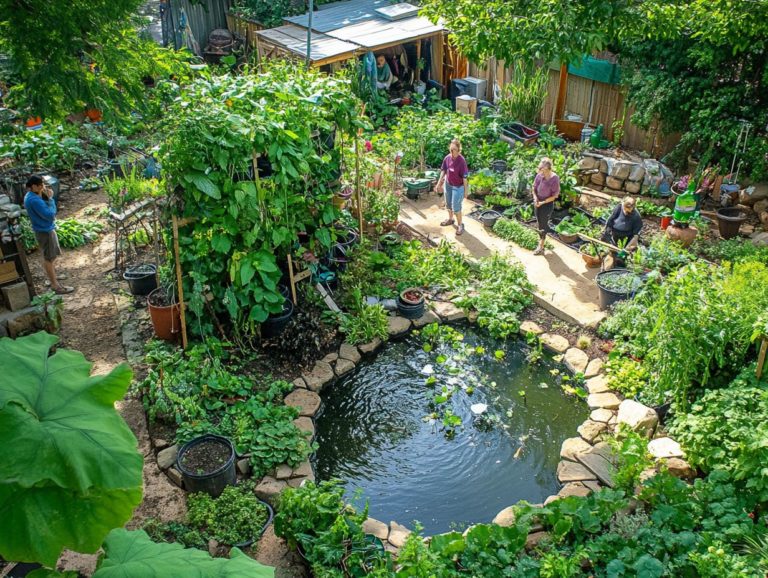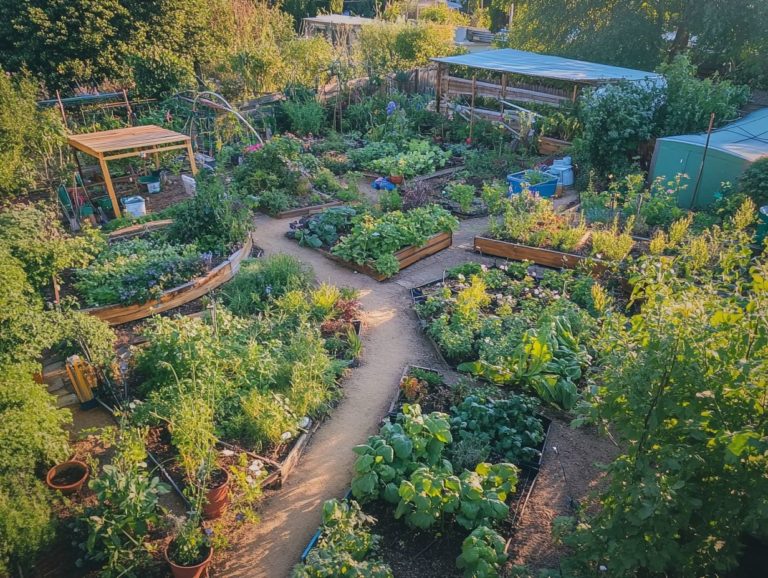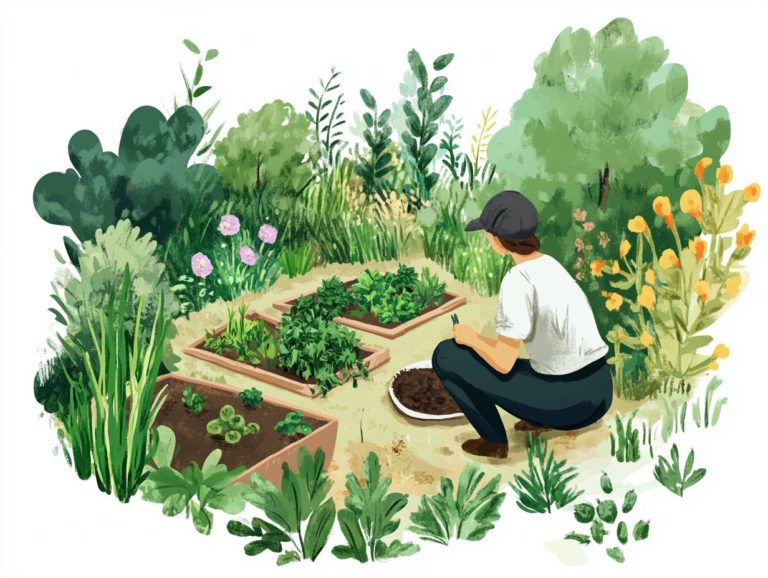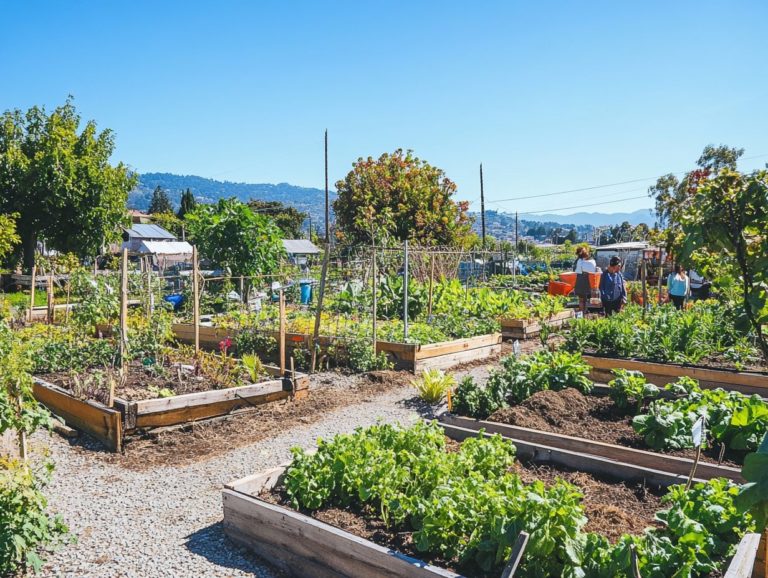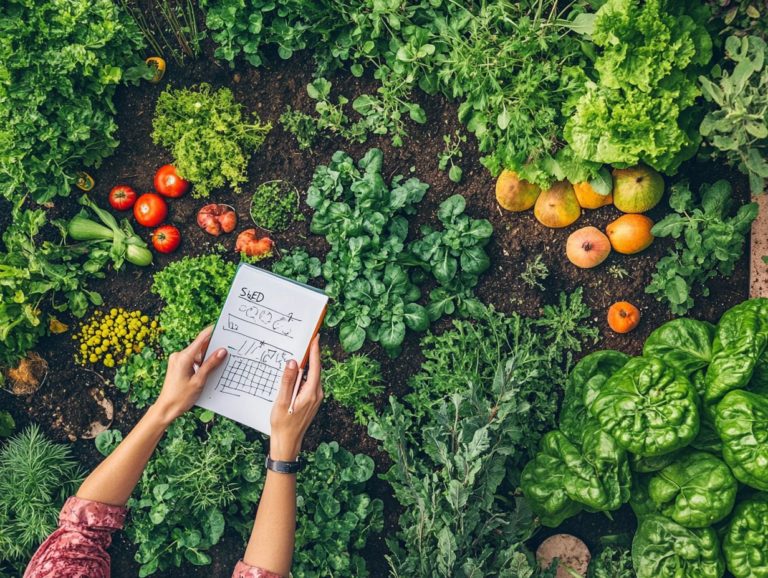Designing for Maximum Productivity in Permaculture
Permaculture is not just a gardening method; it s a holistic philosophy for sustainable living that works in harmony with nature.
Get ready to dive into the exciting world of permaculture principles! This guide will help you understand how to design systems that make the best use of space and resources.
You ll learn about selecting the right plants, setting up efficient watering systems, and using natural pest control methods. This journey will equip you with practical strategies to nurture a vibrant ecosystem.
Whether you re a seasoned gardener or just starting, these insights will empower you to create a thriving and productive environment right in your backyard.
Contents
- Key Takeaways:
- Understanding Permaculture Principles
- Designing for Productivity in Permaculture
- Maximizing Space for Productivity
- Choosing the Right Plants for Productivity
- Implementing Efficient Watering Systems
- Utilizing Natural Pest Control Methods
- Frequently Asked Questions
- Discover the Wonders of Permaculture!
- What is the goal of designing for maximum productivity in permaculture?
- What are some key principles to consider when designing for maximum productivity in permaculture?
- How does designing for maximum productivity in permaculture benefit the environment?
- What are some strategies for increasing productivity in permaculture design?
- Can permaculture design be applied to any type of land or climate?
Key Takeaways:
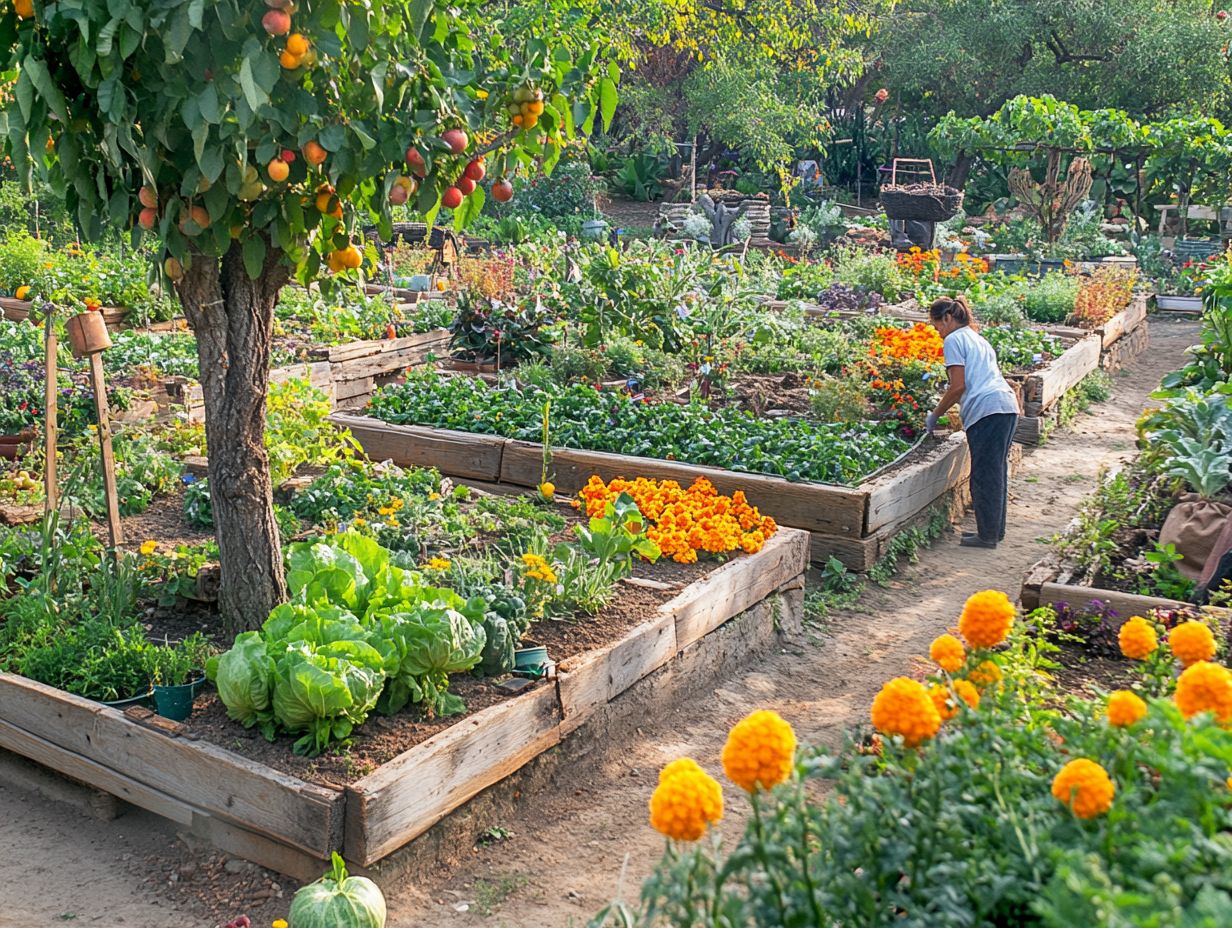
- Choose the right plants and plan their placement for maximum growth.
- Use vertical planting, which grows plants upwards to save space, and companion planting, which involves growing different plants together for mutual benefits.
- Implement natural pest control methods to manage pests while maintaining an eco-friendly approach.
Understanding Permaculture Principles
Understanding permaculture principles is essential for creating a sustainable living environment that supports healthy ecosystems and uses resources wisely.
These principles include important elements of natural design. They focus on building good relationships among plants, animals, and people.
Applying these permaculture principles enables you to design systems that are not only productive but also resilient and self-sustaining. This paves the way for a thriving ecosystem that benefits everyone involved.
Definition and Key Concepts
Permaculture is a design philosophy that emphasizes sustainable ecosystems. It blends ecological design with agriculture to create efficient and self-sustaining environments.
This approach encourages you to explore the intricate relationships within natural ecosystems. By observing and analyzing resources like soil health, water flow, and local flora and fauna, permaculture aims to mimic nature s patterns, fostering resilience and diversity.
This method aims to enhance the variety of life and minimize waste. It also focuses on improving food security, making it relevant in various contexts from urban gardens to rural landscapes.
Ultimately, these principles deepen your understanding of ecological balance, inspiring innovative, sustainable practices that meet the challenges of modern living.
Designing for Productivity in Permaculture
Designing for productivity in permaculture requires a thoughtful approach. You must consider factors such as energy efficiency, maintenance, and how to create a productive permaculture garden that integrates ecological principles.
This ensures that your outcomes are not only sustainable but also rewarding over time.
Factors to Consider
When designing for productivity in permaculture, focus on critical factors like the specific ecological context, available resources, and opportunities for community projects, including designing with perennials in permaculture, to create a sustainable living environment.
To build an effective design, evaluate soil quality, climate conditions, and water availability. These elements are vital in determining which plants will thrive in your area.
Understanding community dynamics will enable collaboration and promote a shared vision, allowing diverse skills to enhance project outcomes.
By considering social interactions and tapping into local knowledge, you can customize your designs to meet community needs, encouraging greater participation.
By integrating these factors, you pave the way for innovative solutions while ensuring your permaculture initiatives yield abundant resources and foster a resilient ecosystem.
Let s begin transforming your space into a thriving permaculture paradise today!
Maximizing Space for Productivity
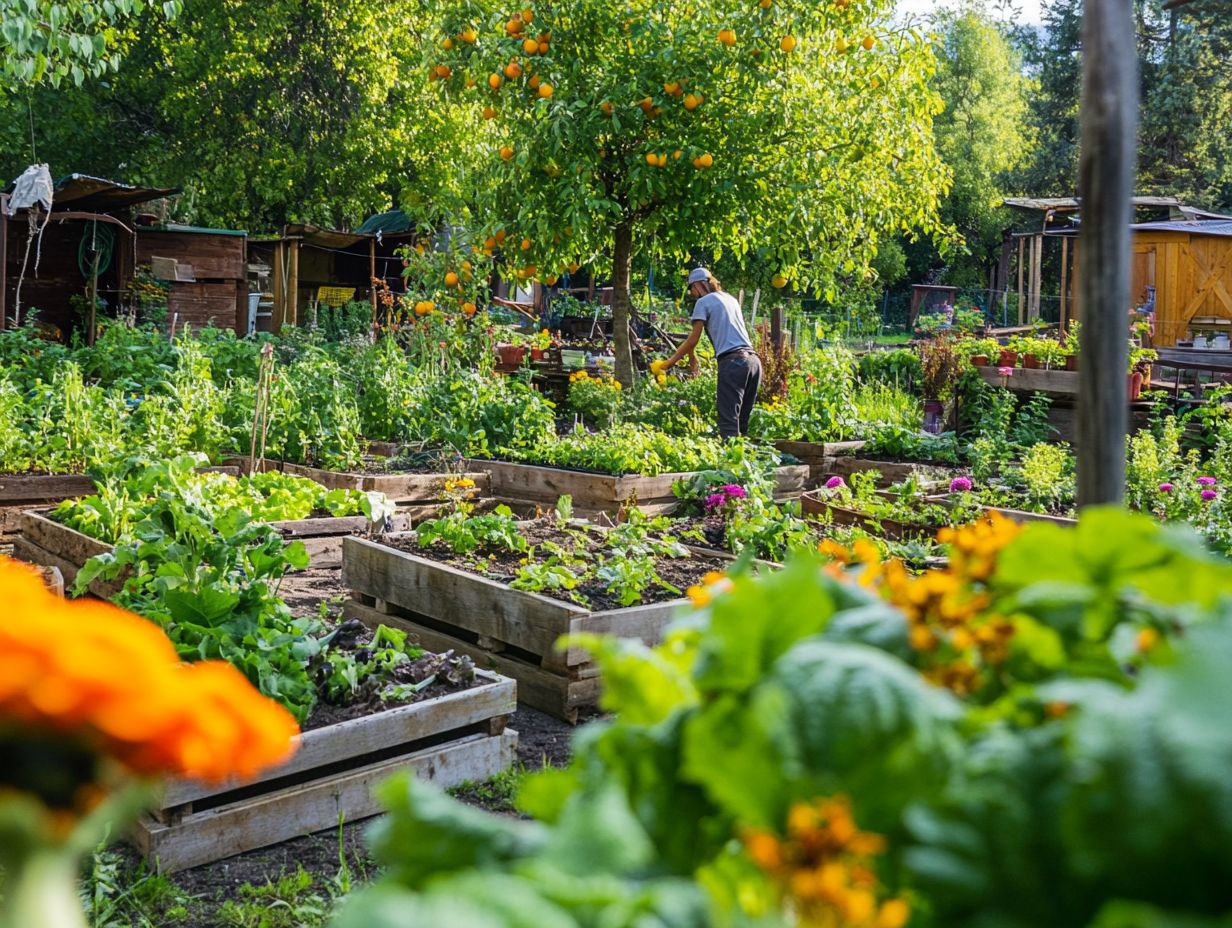
Maximizing space for productivity in permaculture is all about employing innovative techniques like vertical planting and designing for social permaculture through companion planting.
These strategies enable you to make the most of the available area in your backyard garden, transforming it into a thriving ecosystem.
By integrating these methods, you can enhance both efficiency and yield.
This creates a lush environment that works harmoniously with nature.
Utilizing Vertical and Companion Planting
Vertical planting and companion planting are exceptional techniques in permaculture that empower you to utilize space efficiently.
They also foster a variety of plants and animals while promoting sustainable living practices.
By adopting these methods, you can significantly enhance both your garden s yield and the health of its ecosystem.
Vertical planting lets you grow crops upward, employing supports like trellises or walls to maximize light exposure and air circulation.
Companion planting pairs plants that benefit each other, like growing basil next to tomatoes, which helps repel pests and enhances flavor.
These strategies not only optimize your available space but also contribute to ecological balance.
They encourage a diverse environment where natural pest control can thrive.
Ready to transform your garden? Start by adding a few climbing plants into your existing garden beds or experiment with synergistic plant pairings.
You might just be surprised by the fruitful results that await you.
Choosing the Right Plants for Productivity
Selecting the right plants for productivity in permaculture is crucial for attaining ecological integrity.
This thoughtful choice enables the creation of thriving food forests that yield diverse resources for human use while supporting wildlife.
Selection and Placement of Plants
The selection and placement of plants in permaculture are guided by principles called zone planning.
This means organizing plants based on their needs, ensuring they thrive in their best conditions.
This thoughtful process requires you to assess the specific needs of each plant, including its sunlight, water, and soil requirements.
Also, consider its compatibility with neighboring flora and fauna.
When making these decisions, you must keep in mind the local climate and the natural interactions within the existing ecosystem.
By mimicking nature’s patterns and relationships, you can design permaculture landscapes that are resilient and self-sustaining.
Plants will flourish individually while supporting each other.
This approach fosters variety and enhances productivity throughout your garden.
Implementing Efficient Watering Systems
Implementing efficient watering systems is crucial for you in permaculture.
By utilizing advanced irrigation techniques, you can optimize water use and enhance energy efficiency.
This approach not only conserves resources but also fosters a thriving ecosystem.
It allows your permaculture efforts to flourish harmoniously.
Irrigation Techniques and Tips
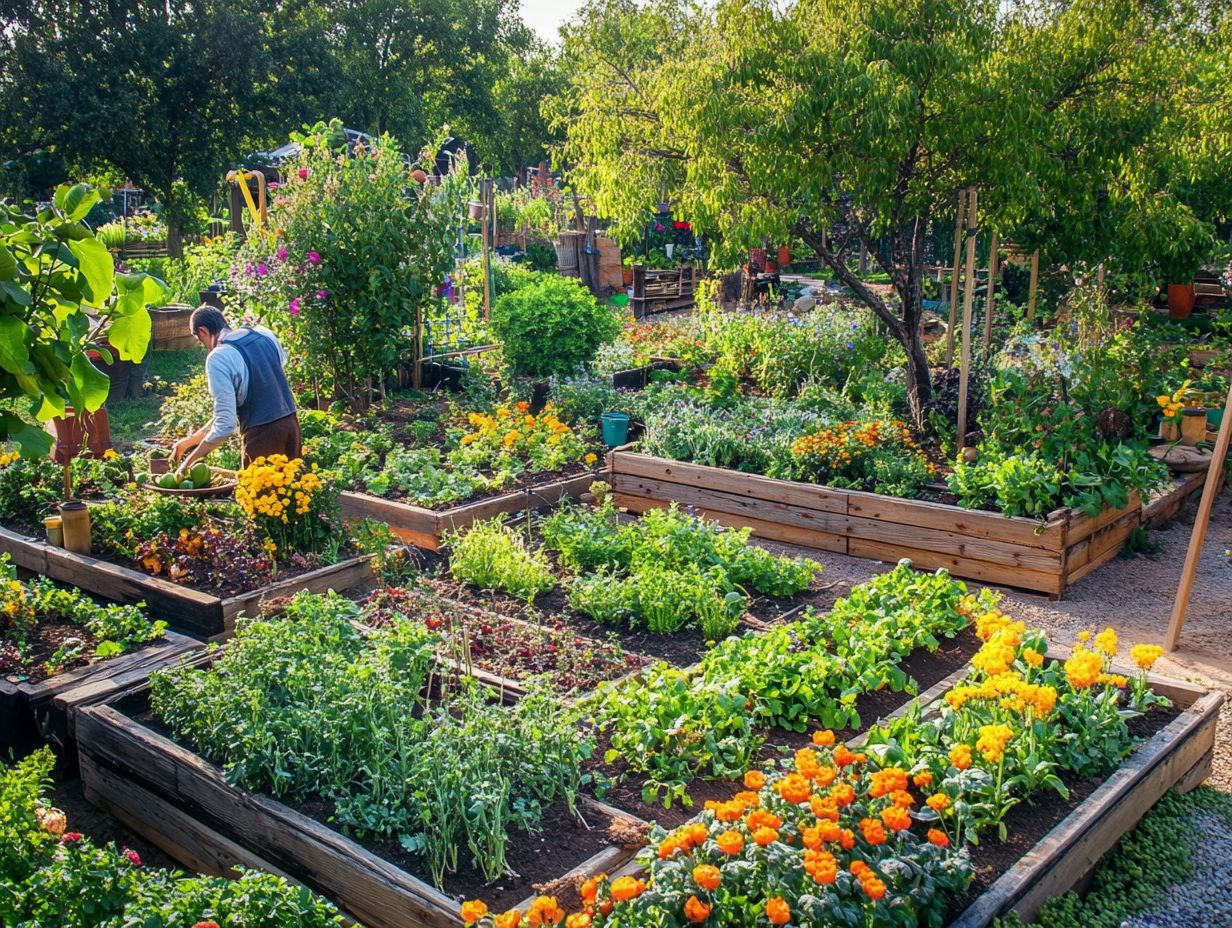
Irrigation techniques in permaculture are essential for effective water management.
They ensure that your plants receive the moisture they need while minimizing waste and supporting long-term sustainability.
Among these techniques, drip irrigation truly shines.
It delivers water directly to the root zones of your plants, conserving water and fostering healthier growth.
Rainwater harvesting is another powerful method.
This allows you to capture and utilize natural precipitation, further enhancing resource efficiency.
Both of these techniques significantly improve plant health.
If you’re considering implementing these systems, dive into efficient watering!
Check for clogs, ensure proper alignment, and monitor water distribution.
These practices can greatly enhance system efficiency over time.
Embrace these techniques today for a flourishing garden!
Utilizing Natural Pest Control Methods
Utilizing natural pest control methods is essential in permaculture. These eco-friendly strategies not only protect your plants but also preserve the ecological balance and integrity of your environment.
Embracing these practices allows you to cultivate a thriving ecosystem while effectively managing pests.
Effective and Eco-Friendly Pest Management
Effective and eco-friendly pest management in permaculture is all about maintaining ecological integrity. By employing strategies that protect your plants while supporting a balanced ecosystem, you re making a significant impact.
This approach reduces harm to beneficial insects and wildlife and nurtures resilience within your agricultural environment. Look around community projects worldwide are achieving incredible success with these eco-friendly methods!
Take, for example, a local cooperative in Northern California. They embraced companion planting techniques. By selecting specific plants that naturally repel pests, they ve cultivated healthier crops without relying on chemicals.
In urban settings, community gardens have also adopted methods to manage pests without chemicals. They attract predatory insects and use organic barriers. This illustrates how collective efforts can pave the way for sustainable solutions.
Engaging your community in these initiatives is essential. Collaboration deepens understanding and commitment to ecological health. Ultimately, this ensures the longevity of pest management practices.
Frequently Asked Questions
Discover the Wonders of Permaculture!
Permaculture is an approach to designing sustainable and resilient systems that mimic natural ecosystems. It incorporates principles and ethics to create productive and self-sustaining environments.
What is the goal of designing for maximum productivity in permaculture?
The goal is to make a system that produces more with less effort and waste. This results in a more sustainable and efficient way of producing food and resources.
What are some key principles to consider when designing for maximum productivity in permaculture?
- Observation and interaction
- Use of renewable resources
- Integrating diverse elements
- Valuing feedback and self-regulation
These principles help to create a harmonious and productive system.
How does designing for maximum productivity in permaculture benefit the environment?
By creating a self-sustaining and productive system, permaculture reduces the need for external inputs and minimizes waste. This results in a smaller environmental footprint and increased biodiversity in the surrounding area.
What are some strategies for increasing productivity in permaculture design?
- Using polycultures
- Companion planting
- Stacking functions
These methods help to maximize the use of space and resources, resulting in higher yields and increased productivity.
Can permaculture design be applied to any type of land or climate?
Yes, permaculture principles can be applied to any type of land or climate. The key is to observe and work with the natural elements of the environment to create a productive and sustainable system. Adaptations may be necessary, but the overall principles remain the same.

